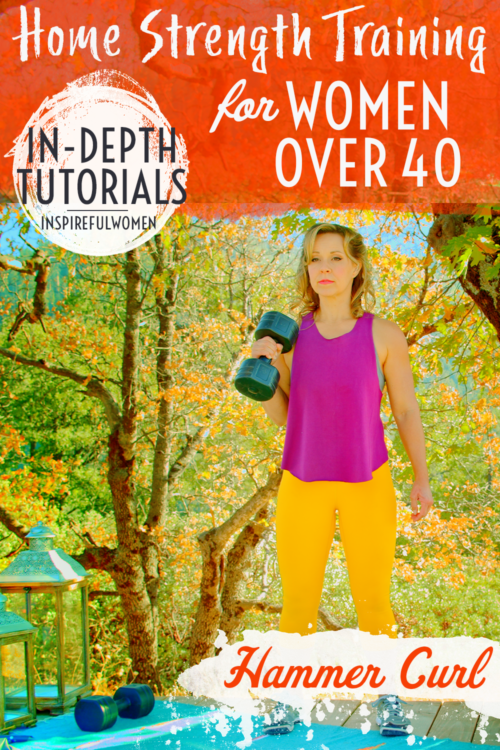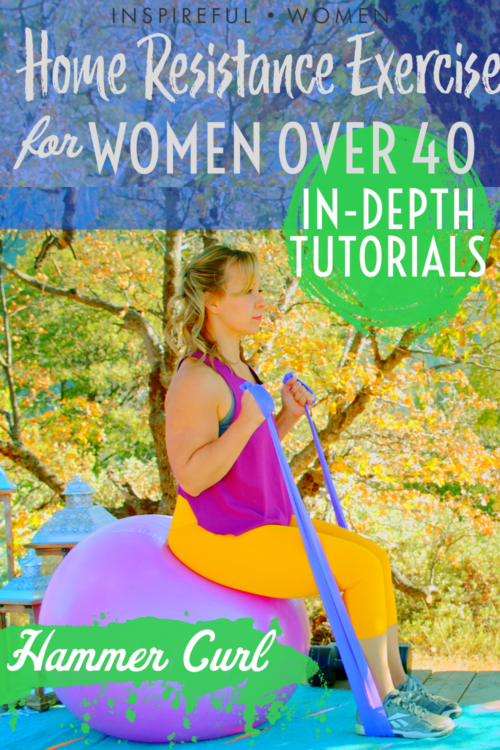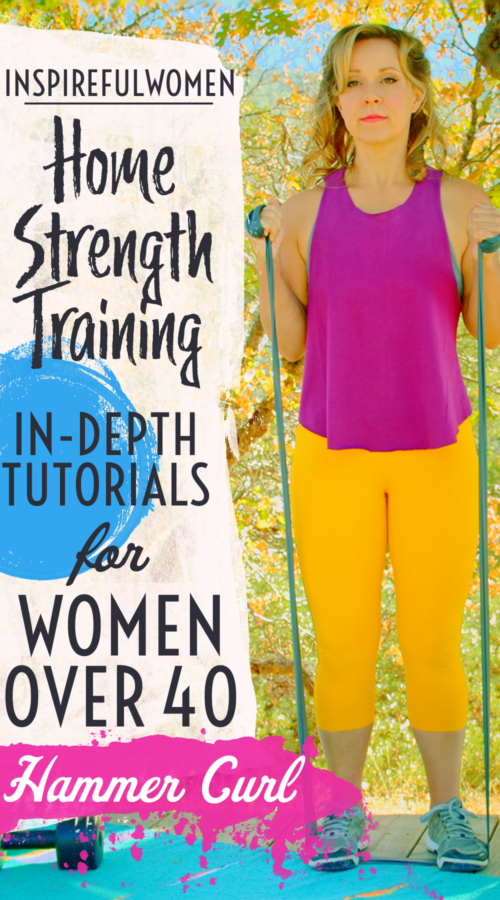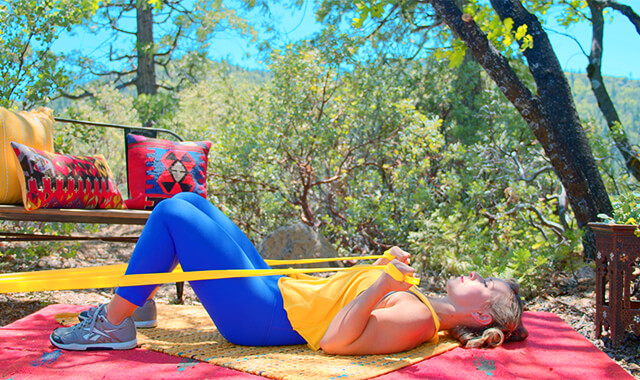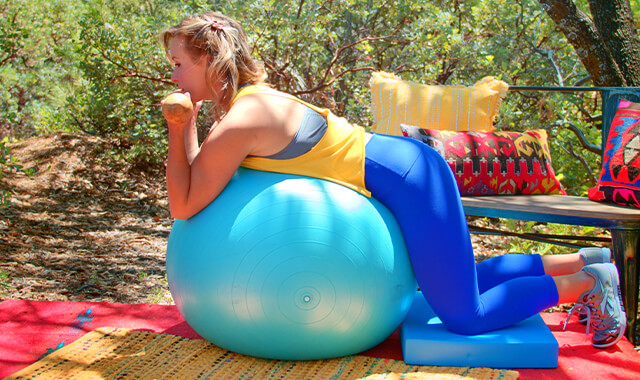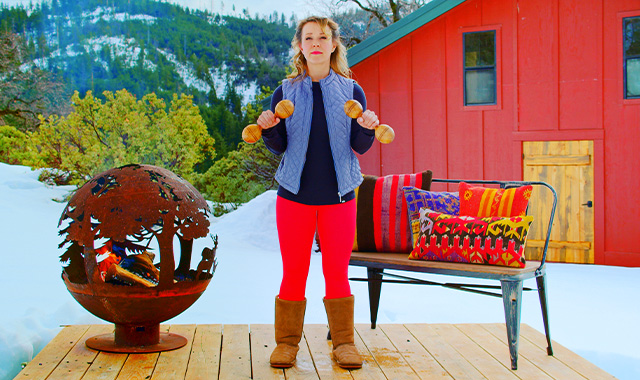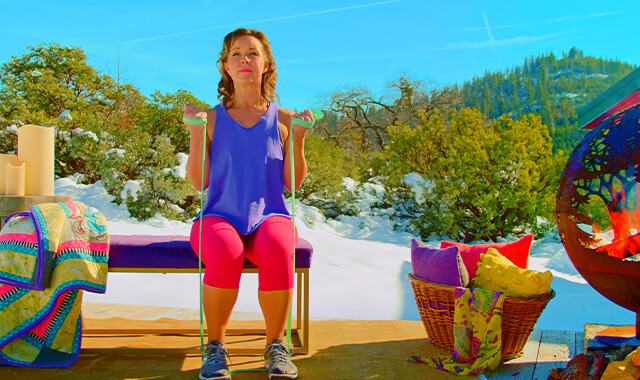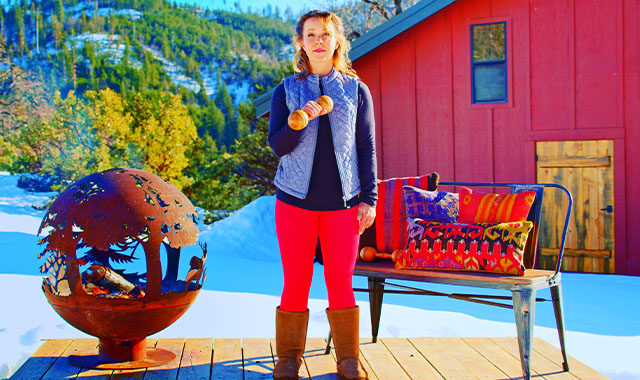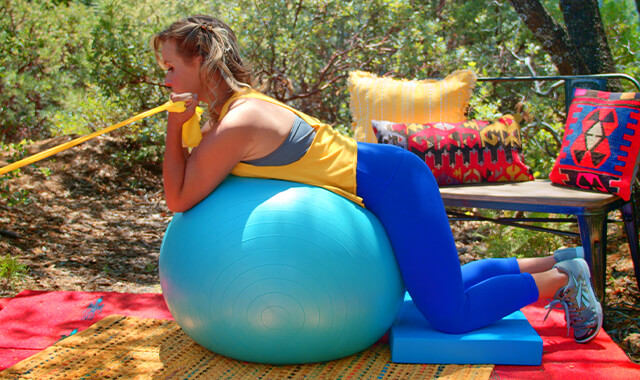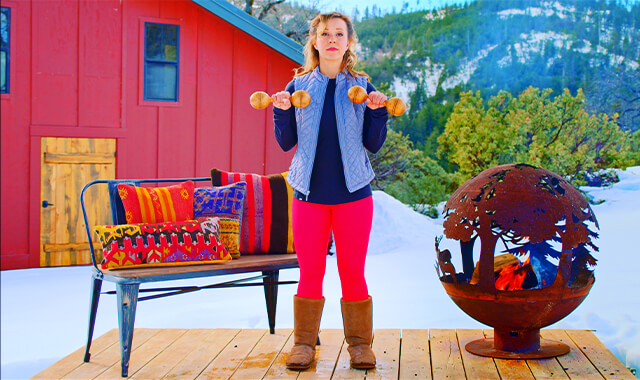Dumbbell Hammer Curl
How to Do the Dumbbell Hammer Bicep Curl Variation | In-Depth Guide [VISUAL LEARNERS]
Proper Form, Common Mistakes, Variations + Easier & Harder | Home Resistance Training
WHAT DO YOU WANT TO SEE?
QUICK DEMO
QUICK DEMO
MUSCLES THIS WORKS
MUSCLES
MAIN MUSCLES WORKED IN DUMBBELL HAMMER CURLS
biceps brachii, brachialis & brachioradialis
These muscles are called "Elbow Flexors" - muscles that bend the elbow.
OTHER MUSCLES WORKED:
- SCAPULAR (SHOULDER BLADE) STABILIZERS to hold shoulder blade down and back
- ANTERIOR DELTOID (front of shoulder muscle) to stabilize the shoulder.
- FOREARM MUSCLES work to stabilize the wrist
WHAT WE'RE DOING TODAY
WHAT & WHY
BENEFITS OF TRAINING the 3 muscles on front of upper arm: biceps brachii, brachialis, brachioradialis
WHAT
WHAT WE'RE DOING TODAY
Other names for this exercise: Neutral Grip Biceps Curl
Check out this standing bicep curl variation! Another easy move! I'm all about that. All we're doing:
BEND YOUR ELBOWS. K, THAT'S IT YOUR DONE.
Well almost anyway!
There are three muscles that bend the elbow, (called flexing the elbow). Hammer Curls work all three of these muscles, with a focus on the two muscles that don't get as much attention - the two that aren't the biceps. If it sounds like I'm being avoidant about saying the names of those two muscles, I kind of am. Because you write them and then BAM you instantly feel like you're reading a dictionary.
Anyways, it's important to know that we have more muscles than just our biceps in that arm area, because we use those other muscles when we bend the elbow too - especially when our palms are facing down or facing each other.
The hammer curl will help us target these other two muscles more so that we can be capable at bending our elbows no matter if our palm is up, down or sideways!
You need to have the strength and control no matter what position your forearm/palm is in, not only when it is rotated palm up (which is when the biceps is strongest). In the thumb up position used for Hammer Curls, the brachialis and brachioradialis will contribute more to elbow flexion than the biceps brachii will.
There I said it, the super weird muscle names.
WHY BOTHER DOING IT?
WHY
WHY DO WE EVEN CARE?
WORKS ALL 3 MUSCLES THAT BEND THE ELBOWS
What is unique about the Hammer Curl? This exercise works all three of the muscles that bend the elbow but, it specifically targets and trains two muscles that are not the biceps muscle. Did I just confuse you? All I'm saying is that bicep curls mostly work the biceps muscle, but this movement helps us to target the other muscles that also bend the elbow.
It's not all about the biceps, so get off your high horse Biceps. Yes you biceps, I'm talkin' to you.
TRAINS 2 ARM MUSCLES THAT GET FORGOTTEN A LOT
Most of us know about the Biceps muscle right? This is the large muscle that is the most visible muscle on the front of the upper arm, and pops out when we actively bend our elbows, also known as “the beach” muscle. But, there is another very strong, and equally important muscle for bending the elbow, that lies under the biceps muscle, called the brachialis muscle.
Surprisingly to me, the Brachialis is not a dinosaur.
The biceps can move the arm in three ways – it can lift the arm up in front of the body, bend the elbow and rotate the forearm.
Unlike the biceps, the brachialis has one function, which is to bend the elbow.
When the palm is not facing up, the brachialis is the prime mover for bending the elbow.
The brachioradialis (not the cousin of the non-dinosaur brachialis) is a smaller muscle that will help out the two other muscles when extra strength or speed is needed.
A standard Biceps Curl is done in a position where the palm is facing up, in this position the biceps muscle is doing most of the work (whichhhh is probably why it’s called a Biceps curl ;)-
When the forearm is rotated to a thumb up position or a palm down position, the brachialis and brachioradialis will be doing most of the work. Which is what we're doing today! The brachialis is also very active when you hold your elbow in a bent position for a long time. Which we're not doing today. :)-
GETS US STRONG ENOUGH TO DO THINGS THAT REQUIRE BENDING OUR ELBOWS IN ANY POSITION!
The position of the forearm/hand will determine which of those muscles are doing most of the work. The biceps brachii is not always in a position where it can strongly bend the elbow. The biceps brachii is strongest when the forearm is rotated so that the palm is up.
But sometimes we bend our elbows while our palms are turned down right? What muscles are going to be able to help us bend the elbow more then huh huh? That's when these other two muscles are of more help.
Since we bend our elbows all day long, and we bend them when the forearm/palm is moving into many different positions, up, down & sideways, it is important to include exercises that target all three of the muscles that bend the elbow so that you will be equally able to use your hands and arms in all positions.
When we can specifically train the other muscles that bend the elbow, just think how much more easily we will be able to do everyday things in life - which we'll talk about next!
The brachialis is often referred to as the “purse flexor” because it is very strong in the position you would hold your arm when a purse is hanging from your forearm.
I think we should just petition whoever is in charge of this stuff to change the brachialis muscle to THE PURSE MUSCLE. It's really not so far-fetched - did you know the word "muscle" comes from the latin word for little mouse? Chosen because they felt many muscles (particularly the biceps) looked and moved like a small mouse to them? Not a joke! So purse muscle sounds perfectly legit to me. Kinda doubt the males of the population would approve though.
IMPROVES COORDINATION & CONTROL FOR MORE ACTIVE....ACTIVITIES
Including exercises that target all three of the elbow flexors will also improve your coordination and control for sports like golf, tennis and working out, because ALL the muscles that bend the elbow will be healthier and stronger.
EVERYDAY LIFE
EVERYDAY LIFE &
MUSCLE FUNCTION
HOW WE USE OUR ELBOW BENDING MUSCLES IN EVERYDAY LIFE
Anytime we bend our elbows, we're using the muscles on the front of our upper arm.
In order to be able to bend the elbows, especially against some sort of weight or resistance, the way our body accomplishes this is by contracting the muscles on the front of our upper arm (between the shoulder & elbow) and that causes the elbow to bend. Functions of these muscles (all of which involve bending the elbows) + examples!
1. HOLDING THE ARM UP AND BENT:
- Writing
- Knitting,
- Holding a book
- Holding a baby
- Carrying a heavy bag or purse with the handles hanging on the forearm
- Painting
- Brushing your teeth
2. PULLING:
- A jug of milk by the handle from the back of the refrigerator to the front
- A refrigerator door open
- Pulling the brush down when brushing hair
- The parking brake lever (your older viewers will know how this used to work!)
- Slot machine lever (I think, I’ve never actually used one).
- A book off of a bookshelf
- Pulling anything when runs handle is up and down.
- I JUST thought of another one - you know when you play tug of war with....oh wait, nevermind, we're not 10 anymore. Well, for those 2 occasions in your adult life when you play tug of war at your child's kid's party, you won't hurt yourself, there ya go.
3. LIFTING
In order to be able to bend the elbows, especially against some sort of weight or resistance, for example:
- Lifting a pan out of the oven
- Raising a box from the floor to the counter (at least if you’re short like me and the counter is too tall to get the darn heavy box on it without bending my elbows!)
- Picking up your kid/grandkid who has decided to be a dead weight and not help at all
- A fork or spoon to your mouth
- A cup or glass
- A suitcase by the handle or backpack strap from the floor
- Laundry detergent by the handle (lifting anything when the handle runs up and down).
HOW TO DO THE EXERCISE
LOOKS
HOW DUMBBELL HAMMER CURLS SHAPE OUR BODY
Muscle growth and toning of upper arm and forearm.
PROPER FORM
STEP BY STEP: HOW TO DO DUMBBELL HAMMER CURLS
EQUIPMENT, SETS & REPS
EQUIPMENT
EQUIPMENT:
Dumbbells.
SUGGESTED STARTING WEIGHT FOR WOMEN:
8-15 pounds
SETS & REPS:
2 sets of 8 – must fatigue the muscle
PACE:
Option 1: Quicker (0.5 sec) up movement (concentric) – increased power will increase the involvement of the brachioradialis. And slow eccentric (lowering) 3-5 seconds.
Option 2: Slower more normal pace-up training for endurance (holding lighter items for longer periods of time).
BODY POSITION
BODY POSITION FOR DUMBBELL HAMMER CURLS
FEET: Shoulder width apart, toes forward
BODY STANCE: Standing upright with neutral spine position, knees slightly bent, sternum lifted, shoulder blades in and down the back.
HAND/GRIP: Palms facing each other/inwards (Neutral grip).
ARM POSITION: Down by your sides. Elbows straight. Upper arm resting by the body but not squeezed in. This will facilitate biceps activation because it will have to support the upper arm as opposed to locking it on the body. It also increases core muscle activity because you are not bracing your trunk and arm together.
NECK POSITION: Neutral and relaxed.
HOW TO DO
HOW TO DO DUMBBELL HAMMER CURLS
CUE: The movement is isolated to bending & straightening the elbow.
Bend your elbows to pull the dumbbells up towards your shoulder, while keeping your elbows still/in place at your sides.
Once you have reached the end of your elbow flexion (fully bent), pause, then slowly lower the weights back down to the starting position to begin the next rep.
HOW TO SAFELY GET OUT OF THE EXERCISE
Straighten your elbows, bend your knees and hips to squat down, and set weights on the floor.
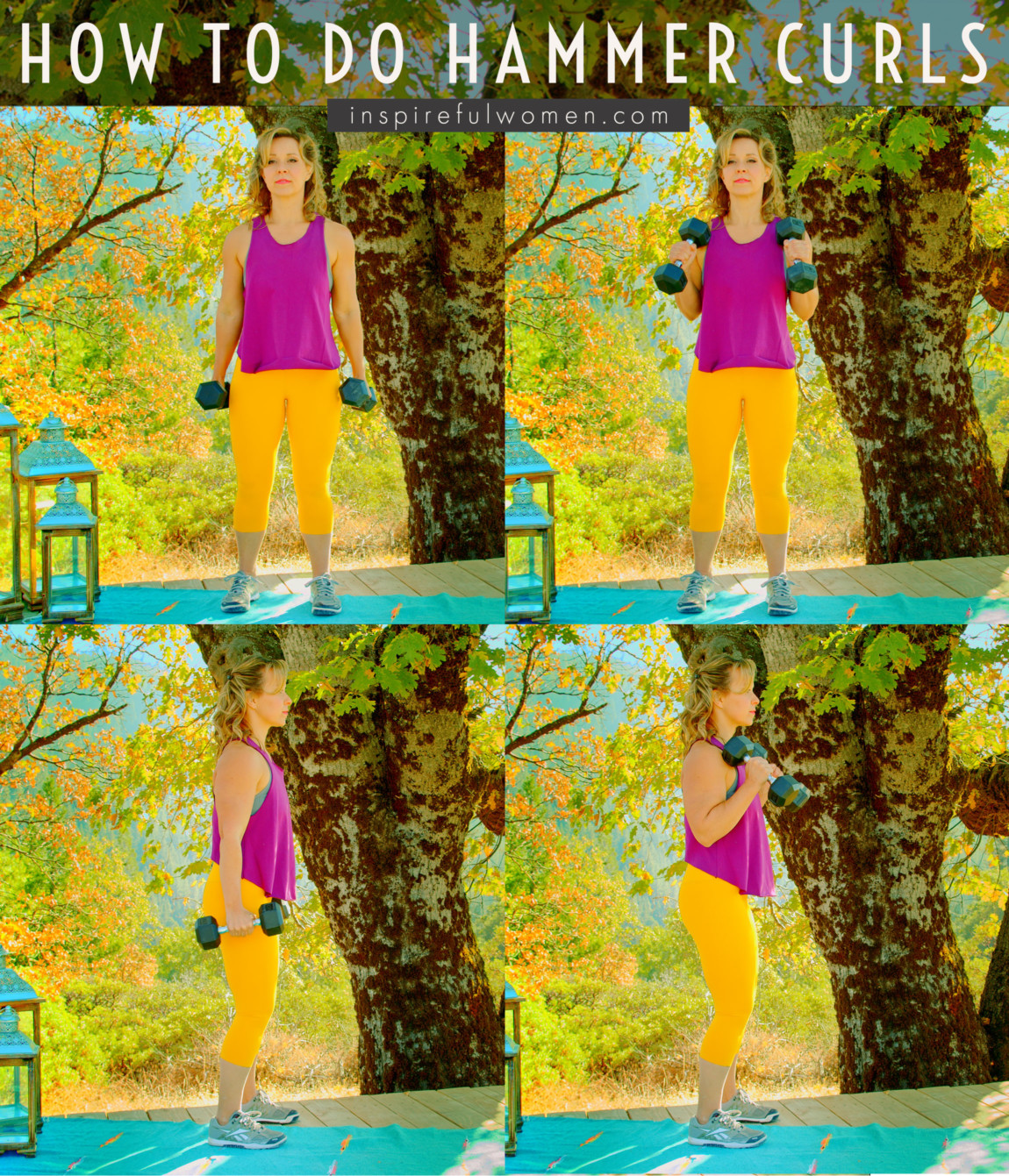
COMMON MISTAKES
COMMON MISTAKES
WHAT TO AVOID WITH DUMBBELL HAMMER CURLS
KEY TIP:
Guess what? Good news! Many avoids are the same for most movements. Once you learn the basics, there's really only a few extra avoids for each individual movement.
1. Avoid rounding your shoulders or upper back
It's easy to let the upper back and shoulders round forward with the dumbbells to the front of us, pulling on us. We want to resist that, and maintain a neutral spine and lifted sternum to avoid stressing the spine.
To do that, pull the shoulder blades down and back and think about keeping a broad chest during the entire movement.
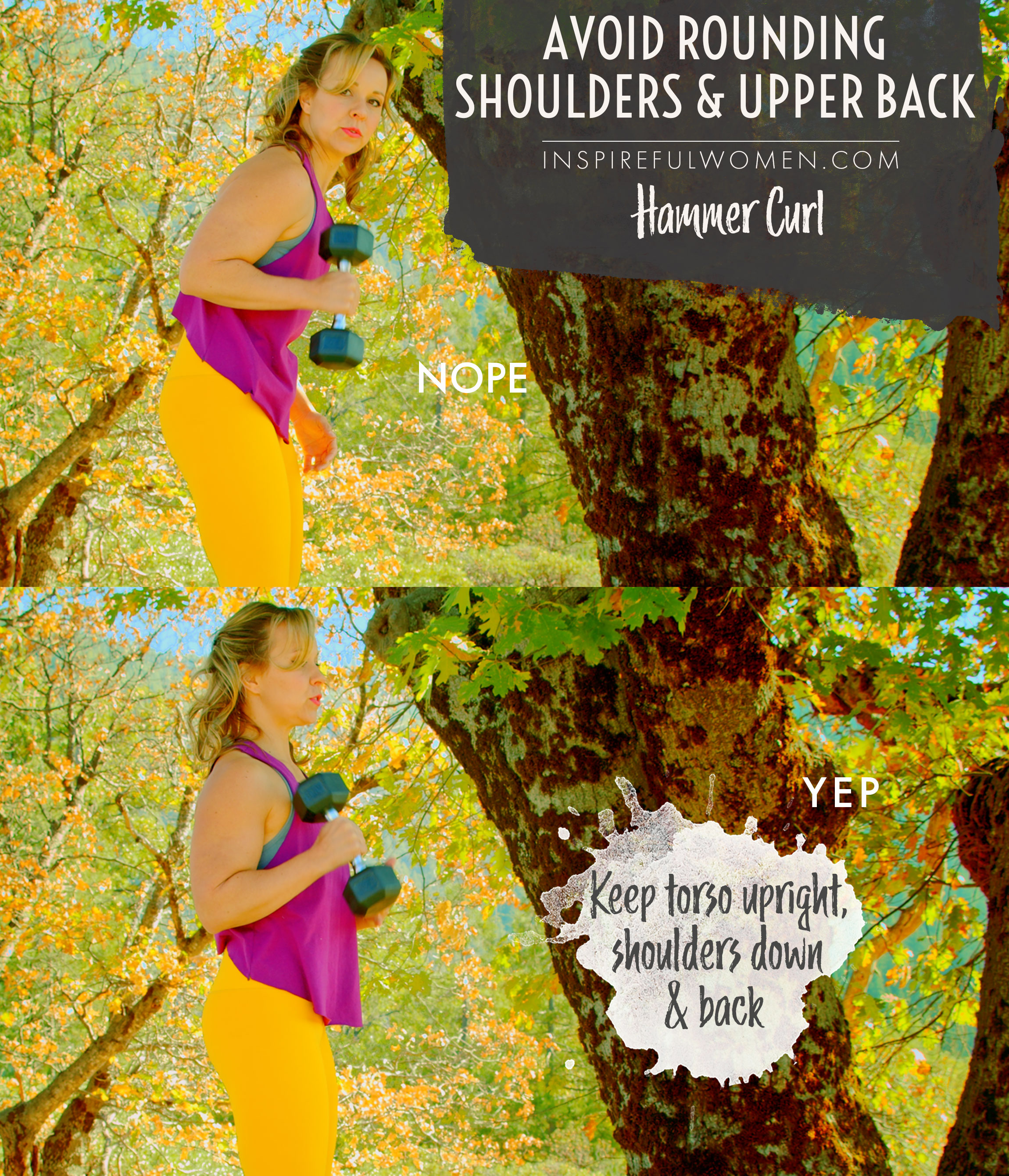
2. Avoid using momentum
Do not swing the weights up and let them fall down. In order to get the benefit of the exercise, pull the weights up and lower them down in a controlled manner. Sometimes I think we understand the not-swinging-up idea, but the falling-down idea can bypass us. When we lower the weights slowly, and with control, this actually works our muscles as well! Just in a different way. The muscle is lengthening under load (the dumbbell) which is making the muscle work very hard eccentrically. This is a great way to build muscle too, so control that down portion.
You want to keep your torso still during the exercise, so that it's your arm muscles lifting the weight, rather than a swinging motion.
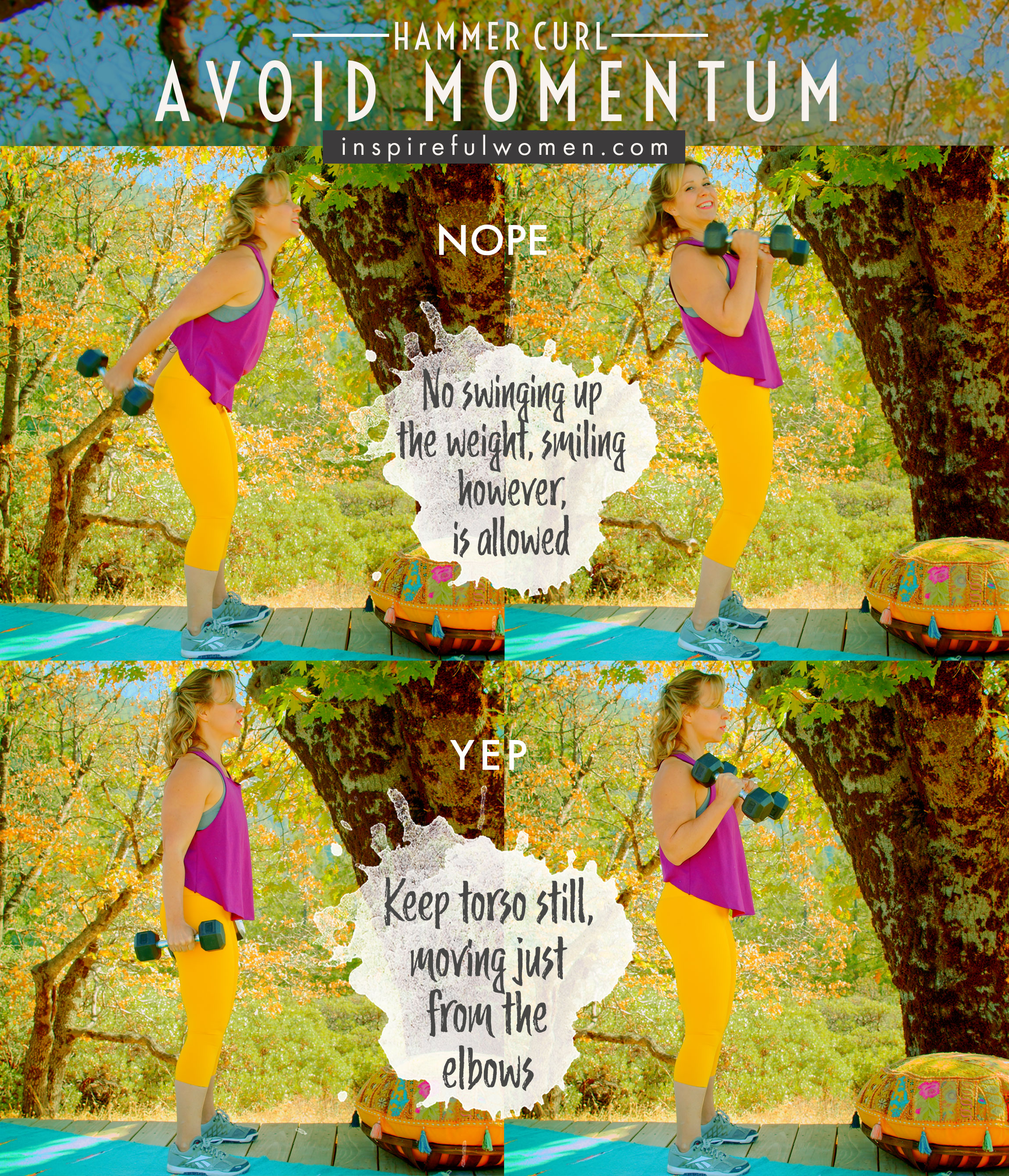
3. Avoid letting your body sway back and forth
Even if you are not actively swinging the weight up, we still might end up swaying our torso forward and backward as we lift and lower the weight. Keep the torso still, and isolate the movement to your elbow.
When you keep the torso still during the exercise, you're not only working the muscles in the front of your upper arm, but you're also working your core muscles to keep your torso still, which won't happen if you let your torso sway.
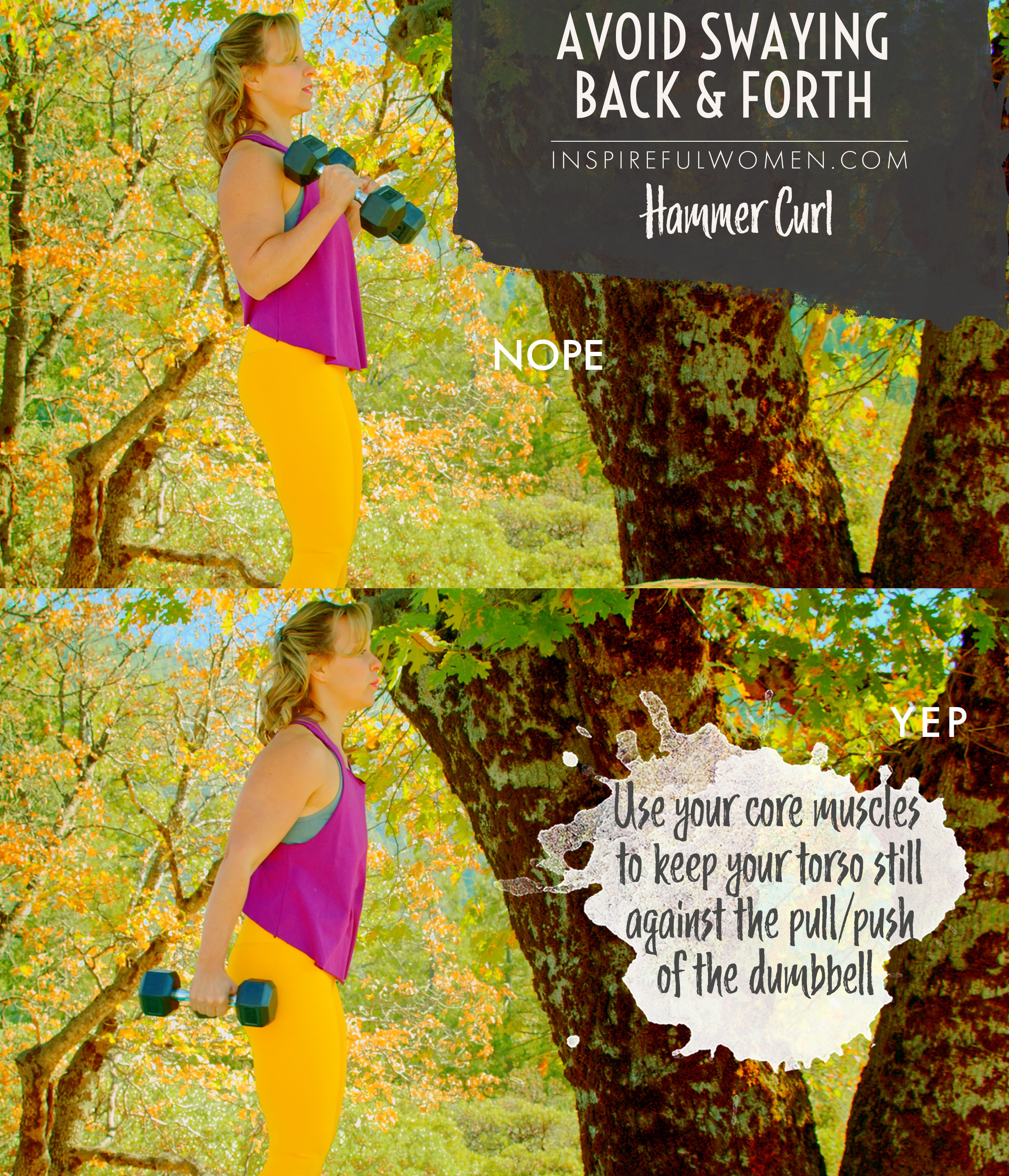
4. Avoid letting your wrists bend or move
Bending our wrists over and over during movements like this, while holding weight like these dumbbells, can really stress the wrist joints over time. This can happen in two ways- either your wrists get pulled into a downward bend by the heaviness of the dumbbell, OR you might actively bend your wrist UP without realizing you're doing it. Both are to be avoided.
You want to keep your wrists in line with your forearm. The bending should be coming from the elbow joint, not the wrist.
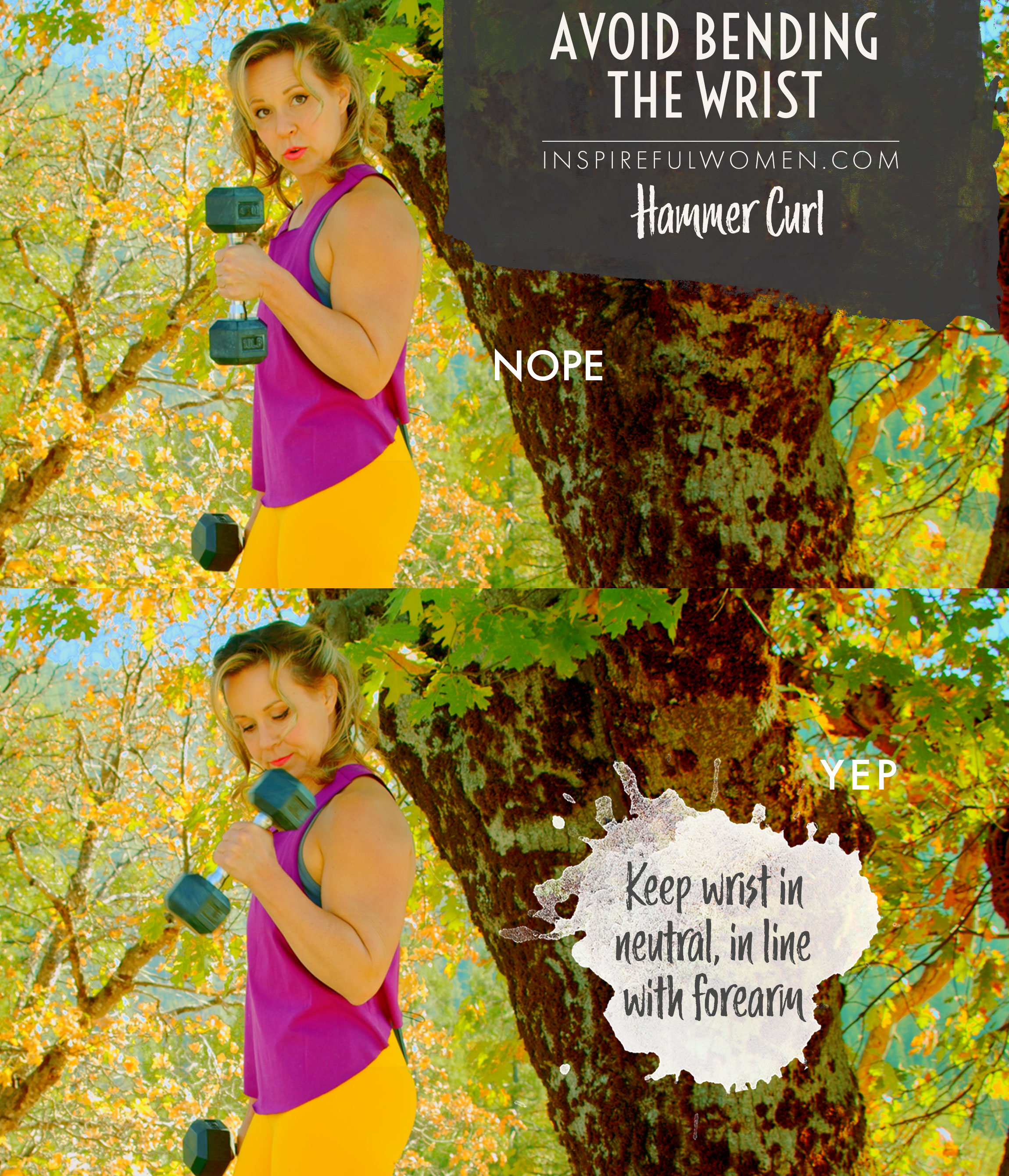
5. Avoid letting your elbows move out to the sides
This will change the downward pull of gravity and will increase the muscle activity of the shoulder, which then reduces how much our front upper arm muscles are working. Since it's our goal with this move to work those muscles on the front of the upper arm, that's why we want to keep the elbows close to the torso, in a position where the right muscles will be doing most of the work.
The upper arm should be resting at your sides, not moving.
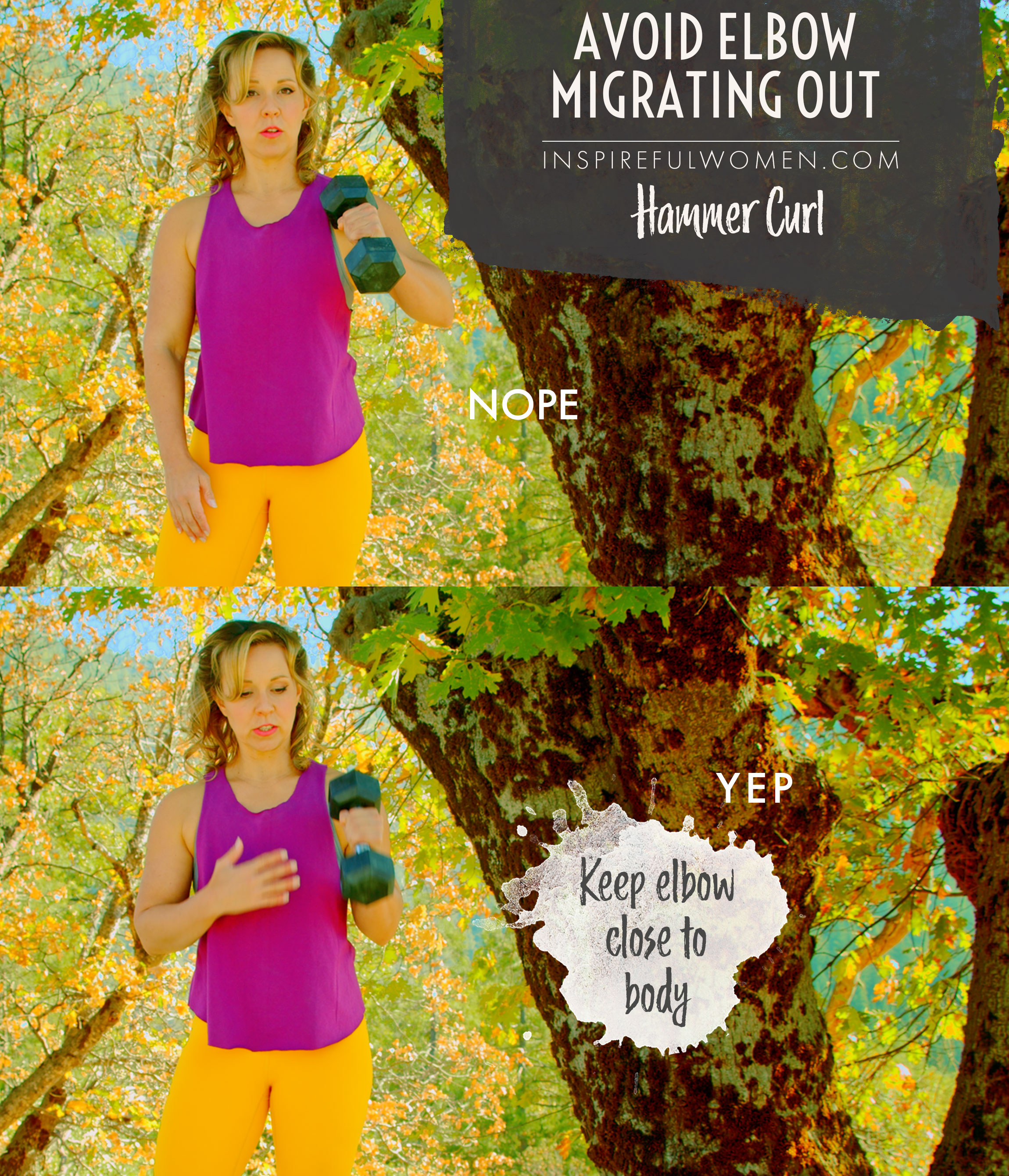
6. Avoid lifting with your neck/upper traps
Our upper trapezius are muscles on either side of our neck where your tank top straps would lay. These muscles will often try to "help out" in various movements without us realizing it. We might unconsciously start raising our shoulders up towards our ears, which is what will then get these muscles more able to contribute.
We want to avoid that by keeping the shoulders press down and elongating our necks.
Letting our upper traps get too involved and hunching our shoulders to our ears can cause tension and pain in our necks and upper back.
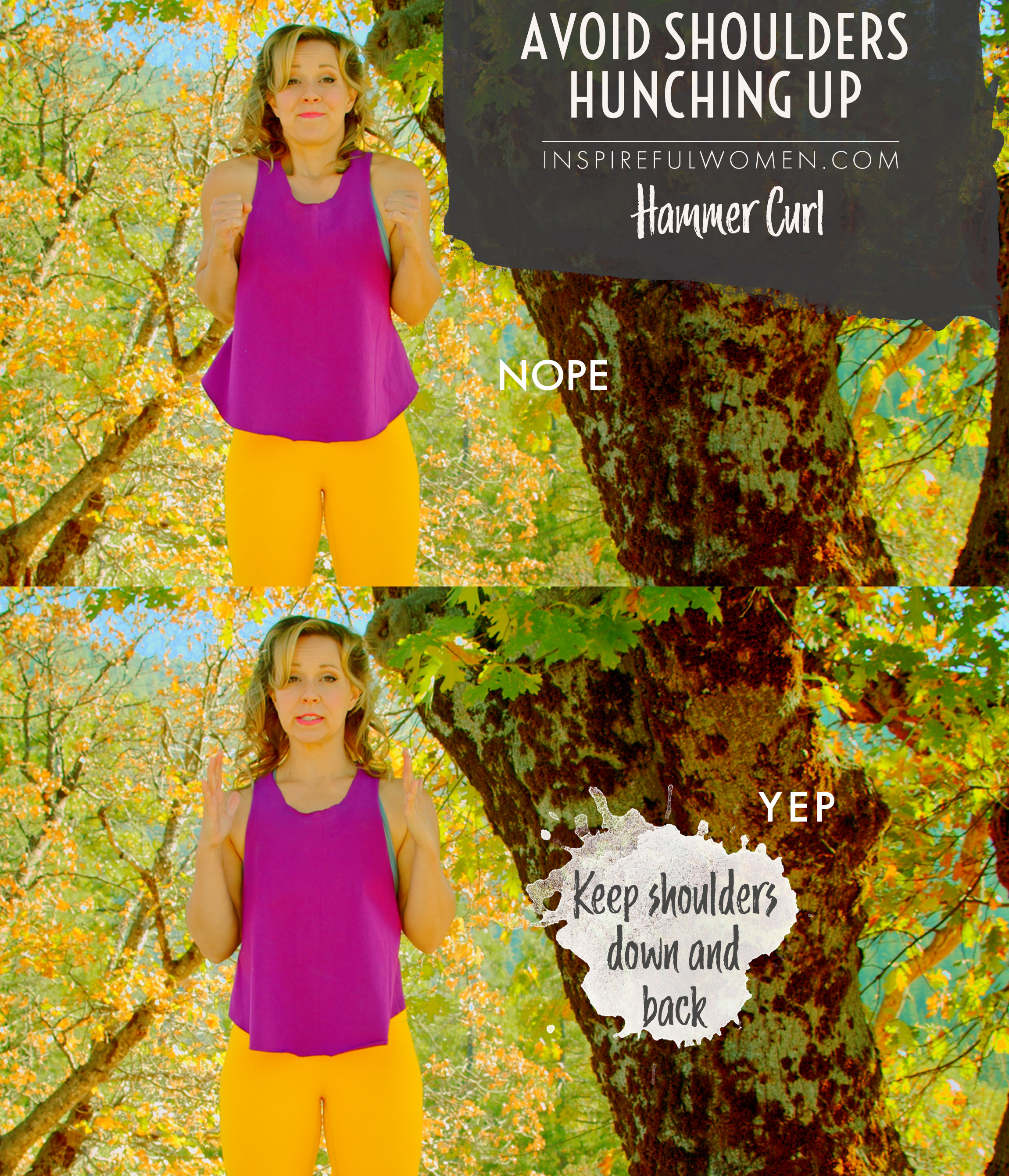
VARIATIONS
VARIATIONS
VARIATIONS OF DUMBBELL HAMMER CURLS
SINGLE ARM
one arm hammer curl
You might wonder what the point is of doing an exercise with one arm at a time, when you could do both arms and get it done faster? Well well well my friend, let me tell ya!
Doing the exercise as a single arm movememtn will change the core muscle activation – the core will not have to stabilize against the weight of two dumbbells, but the core muscles will have to stabilize against a pull to one side – so more of the lateral muscles (obliques and quadratus lumborum). Which is awesome and a very functional thing to train since many of our daily activities in life do not happen in a perfecty evenly weighted way.
Additionally, you can often use a heavier weight for that arm, than when training both arms at once, which means you can fatigue the muscles more effectively.
You can do this while either holding the other dumbbell with your nonworking arm at your side, or even doing an isometric hold with the other "nonworking" arm, where the dumbbell is held with the arm bent to about 100 degrees (which means your forearm would be held just a little higher than parallel to the ground). You can also just not holding anything in your nonworking arm and let it rest at your side.
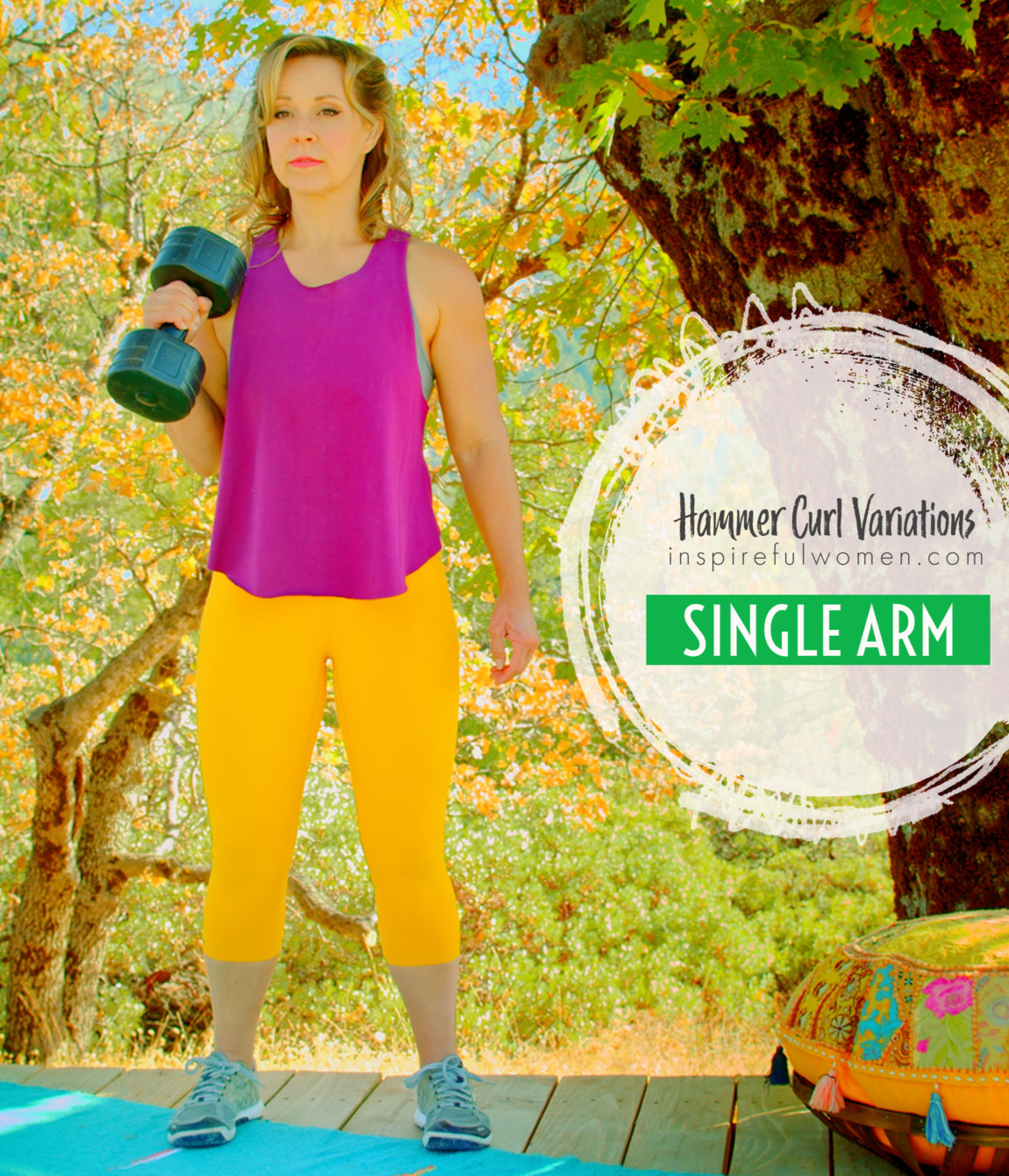
Alternating Hammer Curl
Alternating Hammer Curl
Alternating arms, doing a rep with arm, then switching to the other arm for the next rep, and so on, gives each arm a break between each rep. This can make lifting a heavier weight more doable because of that slight rest between reps.
Or, if you are fatiguing, this can be a way to give your body more of a break so that you don't tired out too quickly to do your entire set.
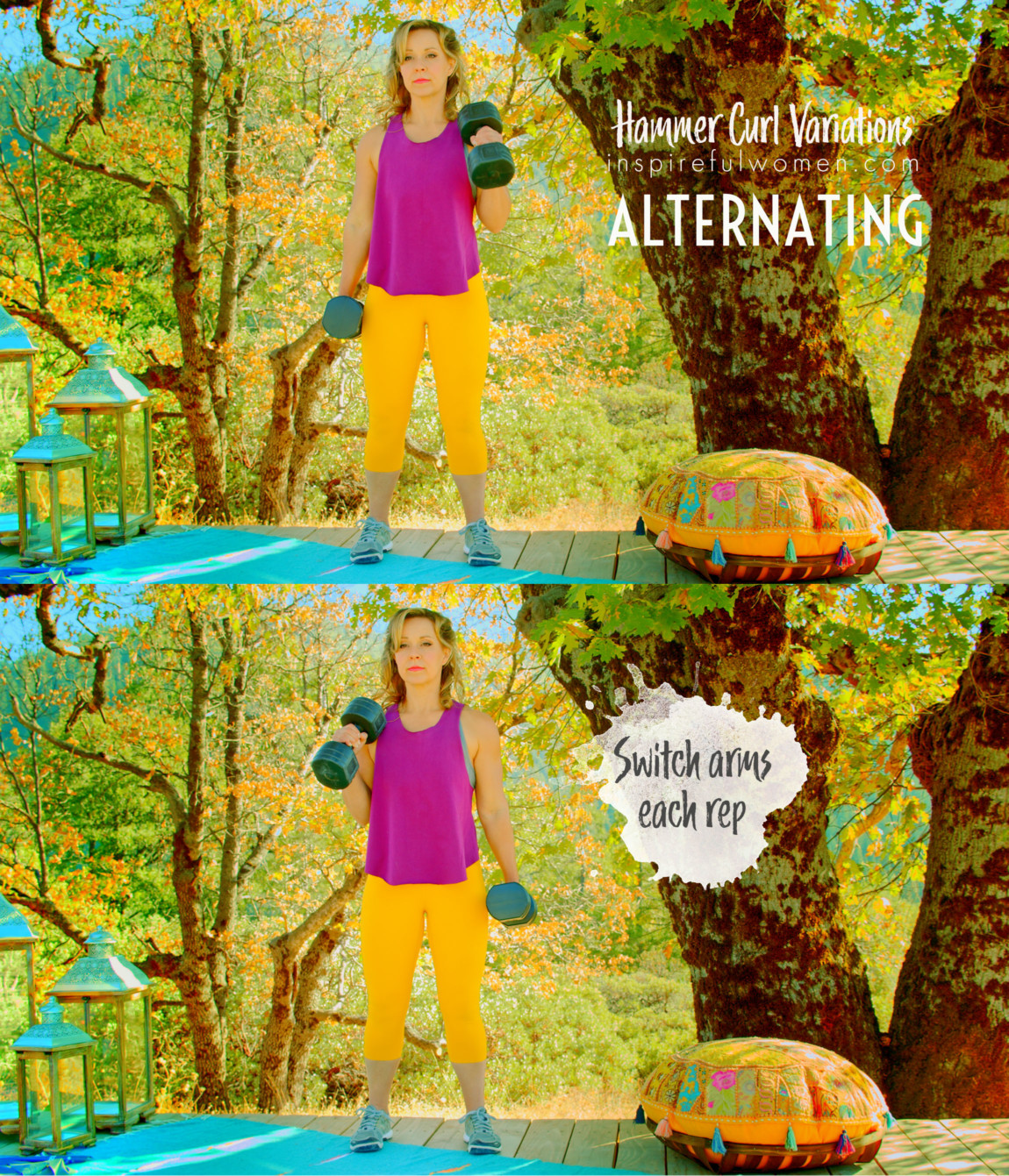
Band hammer curl
Resistance band hammer curl
Use a resistance band instead of weights. Stand with the band under both feet, your hands holding the ends.
This will change the position of maximum resistance which is just a fancy way of saying the bands change where the exercise feels hardest.
Instead of the exercise feeling hardest to the muscles when your elbow is bent to 90 degrees (parallel to the ground) - this would be called the greatest resistance at 90 degrees of elbow flexion with the dumbbells, instead with the band the exercise will feel hardest when you've bent your elbows all the way up - so the greatest resistance will be at the end or the range of motion (maximum elbow flexion).
Remember to keep your wrists neutral, not letting them bend during the banded version, bands are notorious for getting us to bend our wrists a lot without realizing it.
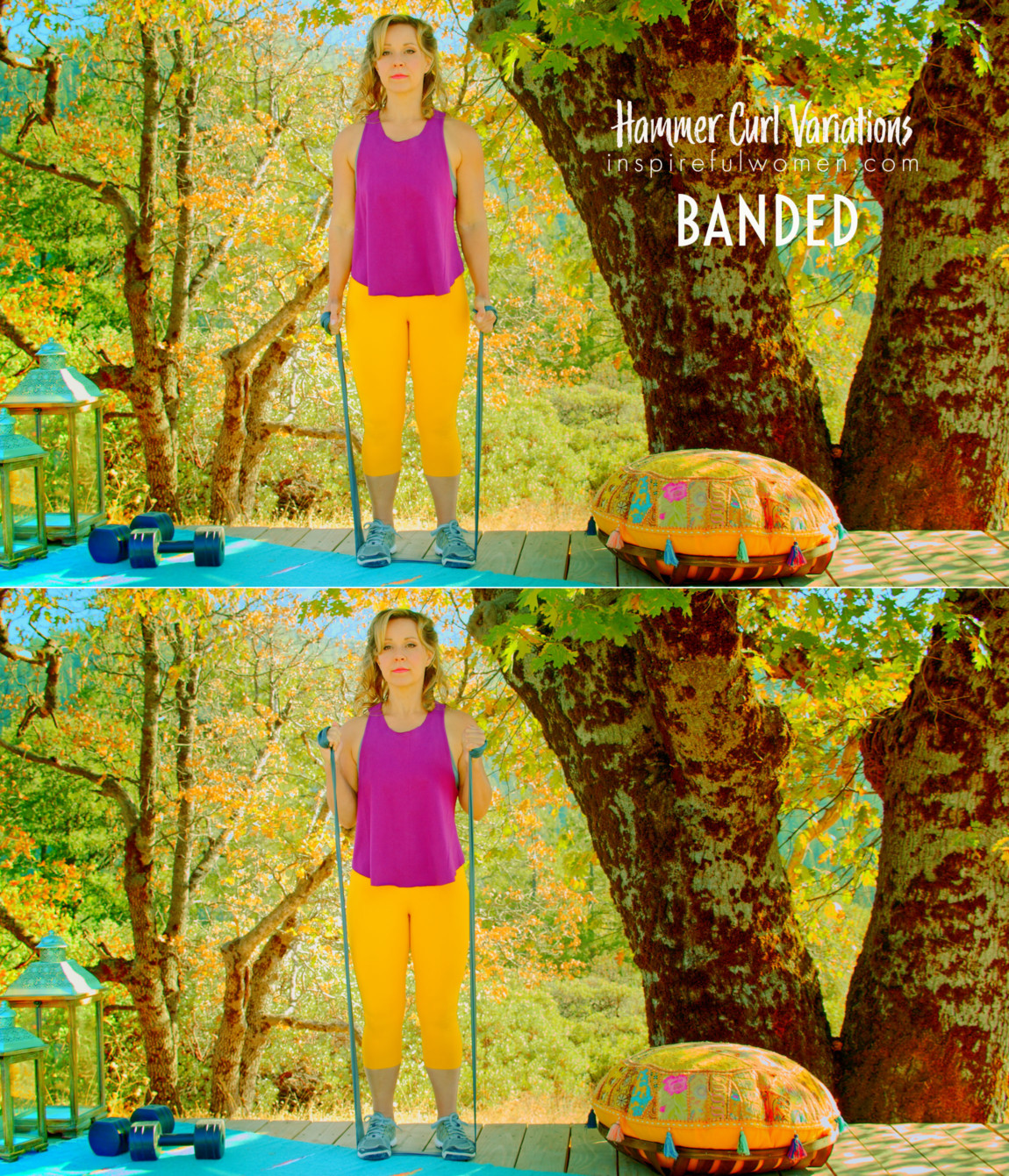
CROSSBODY hammer curl
Cross Body Hammer Curl
We have a full tutorial for the crossbody hammer curl here.
The purpose of this variations is to target the brachialis muscle more than the biceps muscle because the biceps is a muscle that the turns the palms up (called the supinator) and in this exercise we will purposefully turn out palms DOWNWARD instead, so that we reduce the biceps ability to help during the movement.
This version is done with one side at a time. Begin with the arm hanging down by the side with the palm facing in towards your hips - this is called a netural forearm position.
As you bend your elbow (flex the elbow) up, move it diagonally towards the opposite shoulder and turn the palm downward as you do so (although the hand will end its upward movement about mid chest – not all the way to the shoulder). This will turn the forearm into a pronated (palm begins to turn downward) position. Make sure not to reach so far across your body that your shoulder rotates forward with the arm.

MAKE IT HARDER
HARDER
MAKING THE DUMBBELL HAMMER CURLS MORE CHALLENGING
INCREASE WEIGHTS AND/or ISO HOLDs
heavier weights and/or isometric hammer curl
Definitely increase the weight amount you use as your strength increases.
Additionally, increasing the time that your muscle is under tension during a rep will increase the muscle fatigue you experience from those reps. The way to do that is to do an isometric hold, often called iso holds - once you've lifted the weight to about parallel to the ground, or a little higher, hold that position for 3-5 seconds, then finish fully bending the elbow - you can do another 3-5 second pause here if you like at the top of the movement, then slowly lower.
An iso hold with the forearms parallel to the ground (90 degrees of elbow flexion) will work the biceps muscle most, and holding the forearms at 100 degrees of elbow bend, a little higher than parallel, will work the brachialis muscle most.
This will fatigue your muscles very well, as well as being able to do so with a lighter weight. If you only have dumbbells that are either feeling too light for a set or too heavy for a whole set, using the lighter weight with these iso holds can be a way to bridge that gap - those lighter weights will still be able to fatigue the muscles, and then eventually your strength will increase to do a regular paced set with a heavier weight.

keep elbows bent AT BOTTOM
keep elbows slightly bent at bottom during set
Keep some bend in the elbow for the entire set – this will keep some tension on the muscles at all times, so that essentially the muscle never gets any rest for the whole set. This is another good way to help the muscle fatigue faster and more efficiently.
To do this, when you lower the weight, just do not fully straighten your elbows at the bottom, keep a bit of a bend at the bottom before then going back up for each rep.
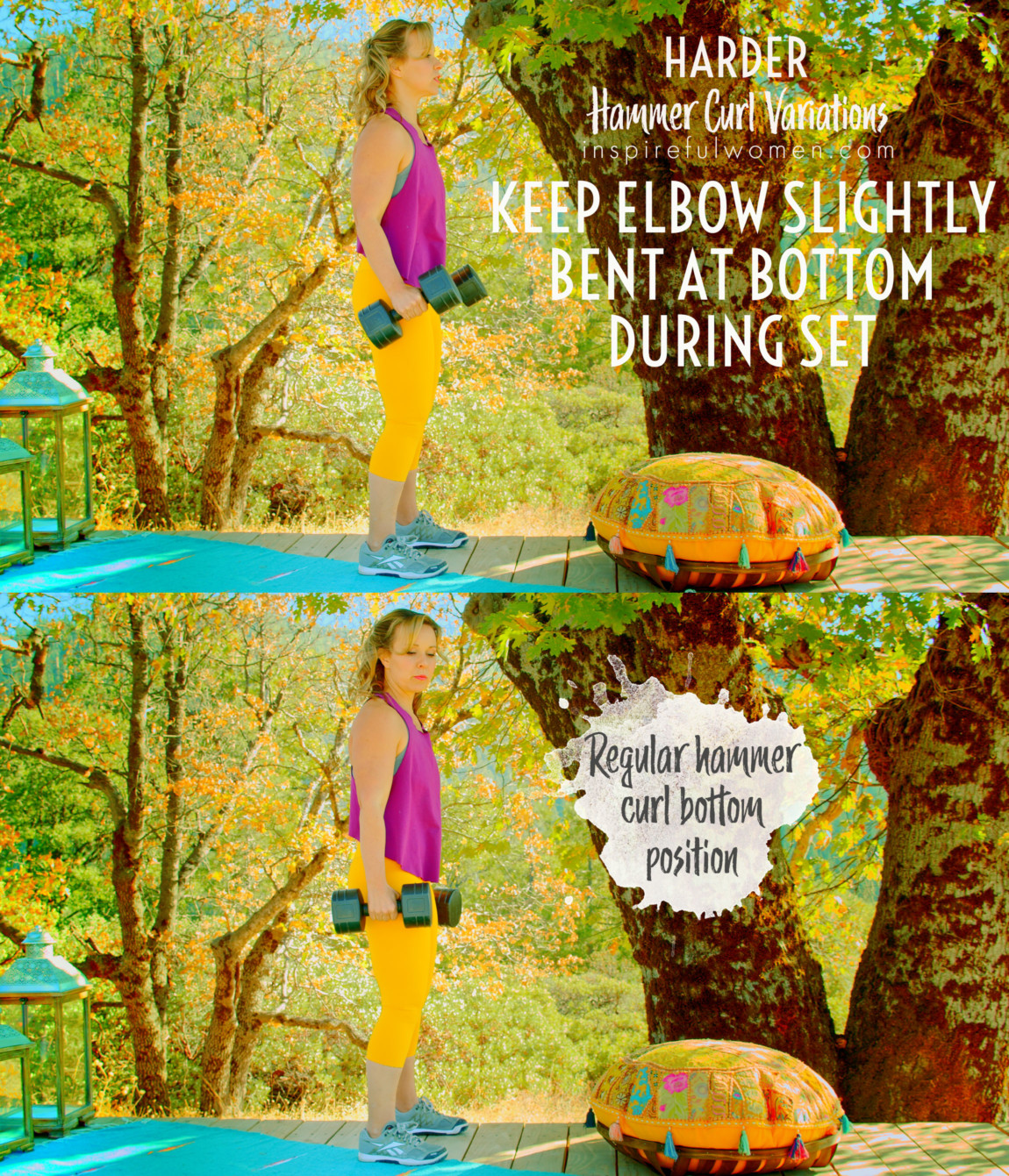
MAKE IT EASIER
EASIER
MAKE THE HAMMER CURLS MORE DOABLE
SEATED HAMMER CURL - dumbbell
DB Seated Hammer Curl
You can do this exercise seated so that the focus can be on the arm movement, and you don’t have to worry about stabilizing the rest of your body at the same time.
This position decreases how much the core muscles are working.
Try to find a seat that allows your arms to have free range of motion at your sides- either something not too wide or sitting on the corner of the chair, bench or stool.
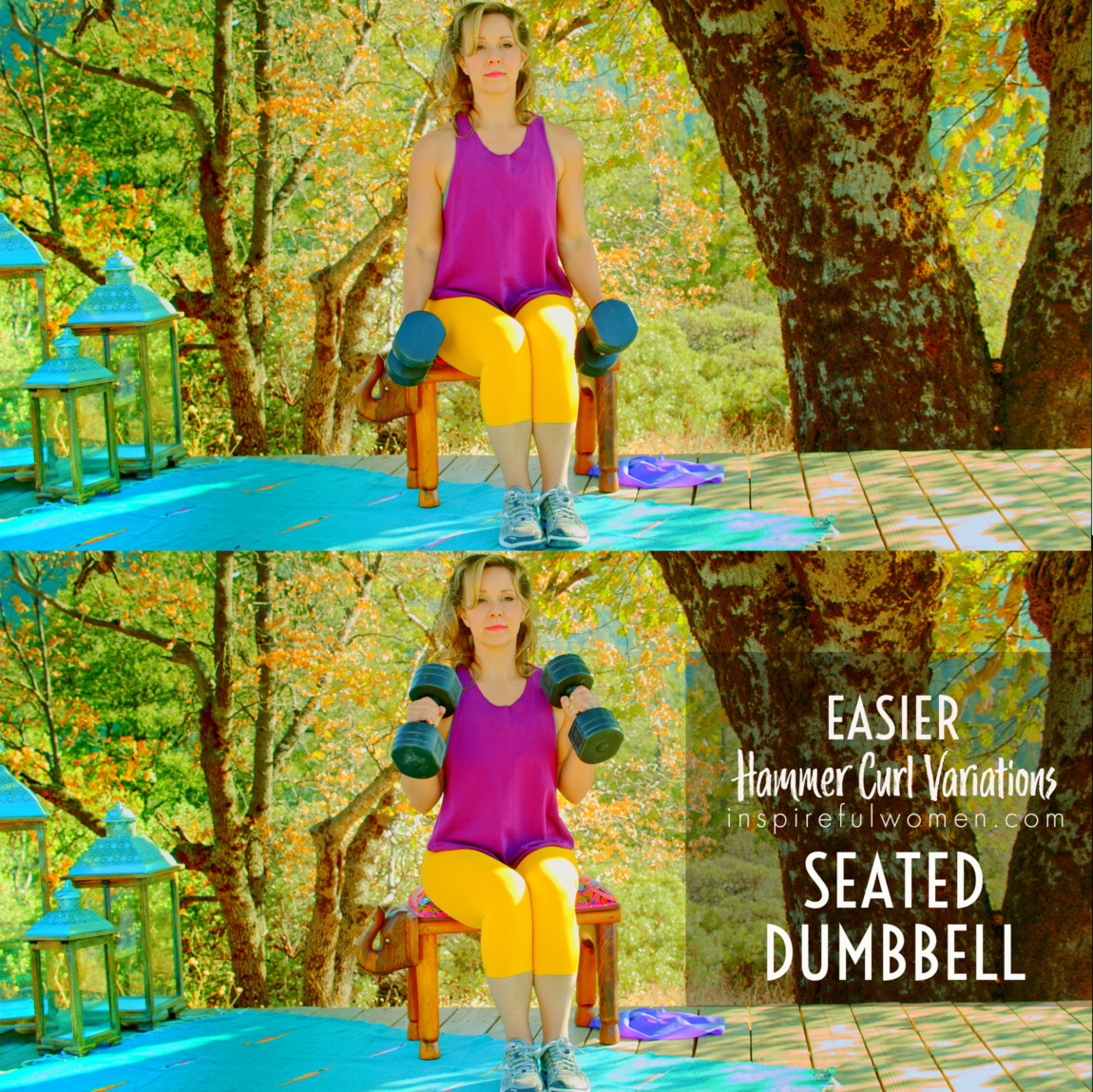
seated hammer curl - band
seated with resistance band hammer curl
You can easily do this movement seated with a band as well. When seated, the band is held in place underneath both feet.
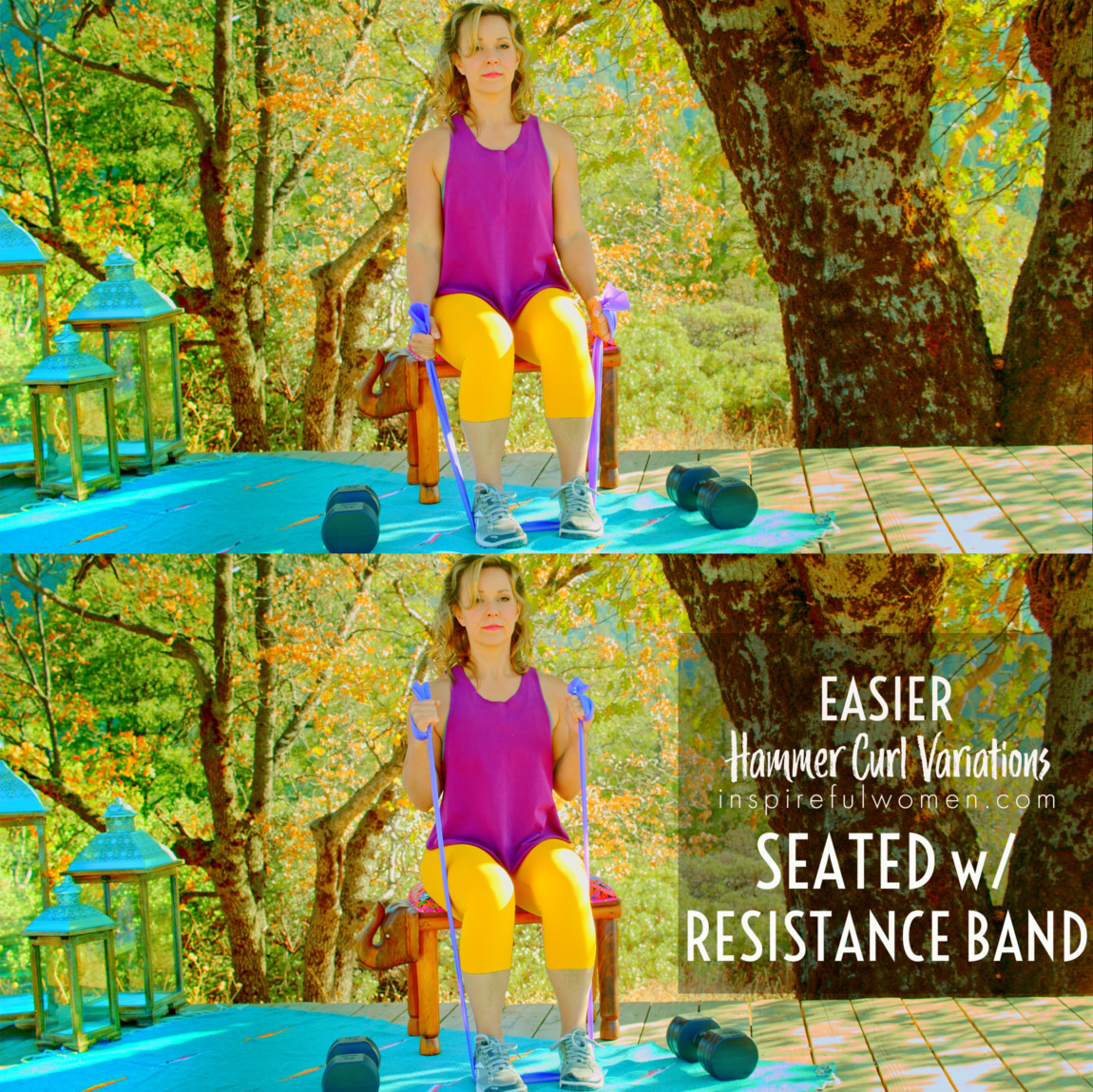
stability ball hammer curl - dumbbell
seated on stability ball with dumbbells
Doing the hammer curl on a stability ball will be easier on the core muscles than the standing position, but harder than sitting on a chair. Because of the unevenness of the ball/how it shifts and moves beneath your weight, it will require your core muscles to turn on and off at various points to keep you stable and still. Which is awesome!
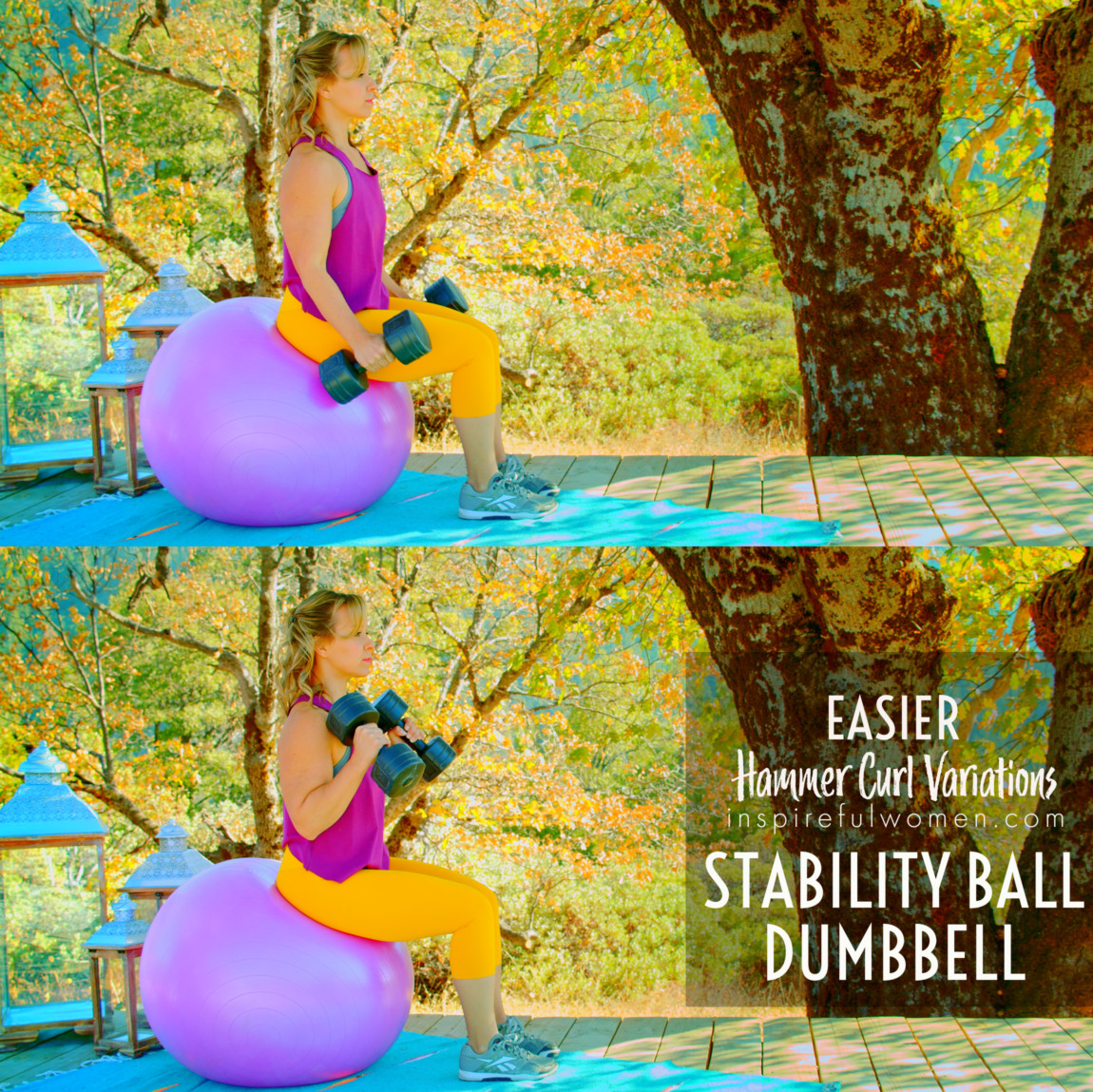
stability ball hammer curl - band
Seated on stability ball with resistance bands
Same dealio here as the dumbbell version of this:
Doing the hammer curl on a stability ball will be easier on the core muscles than the standing position, but harder than sitting on a chair. Because of the unevenness of the ball/how it shifts and moves beneath your weight, it will require your core muscles to turn on and off at various points to keep you stable and still. Which is awesome!
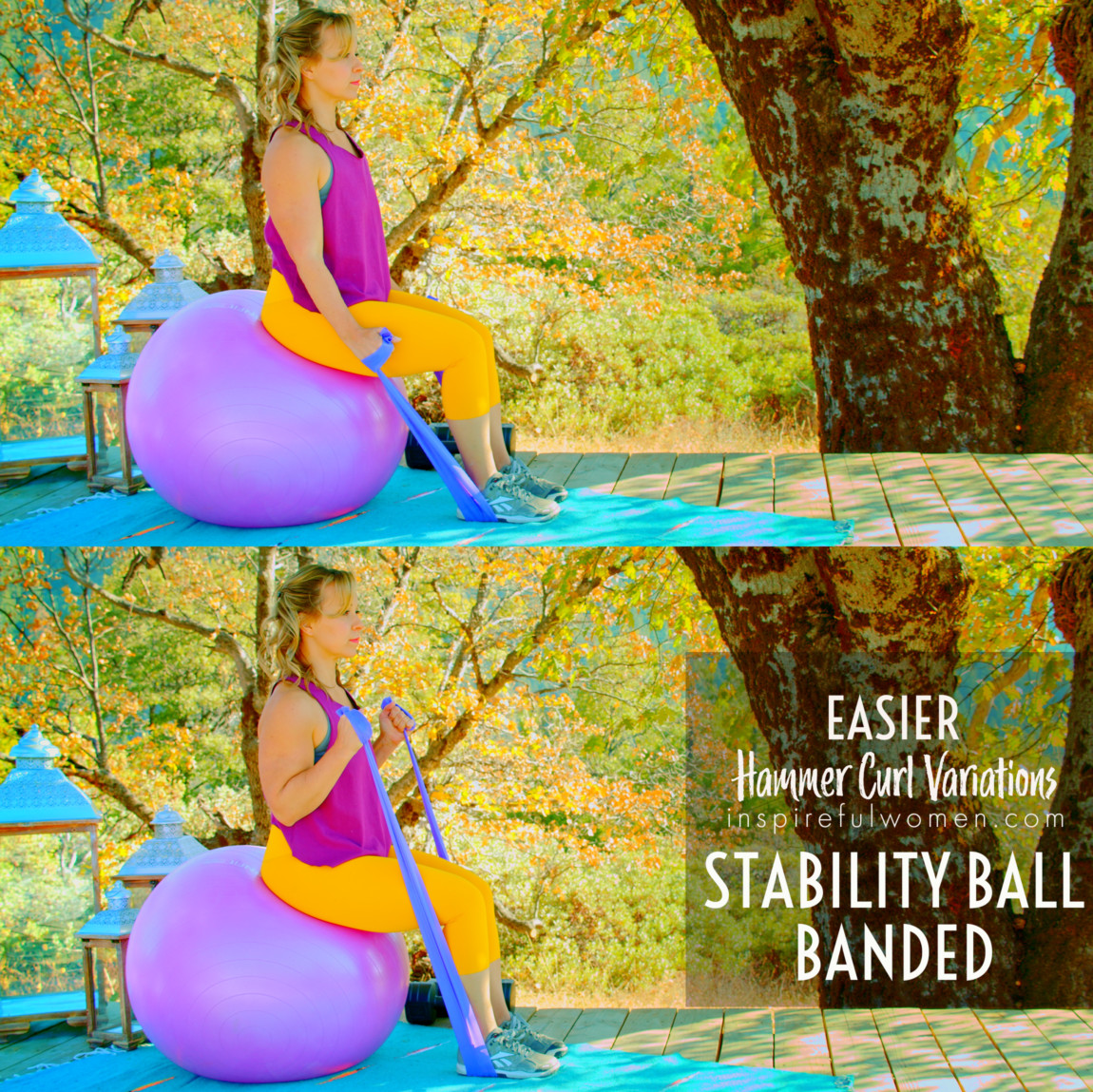
SCIENCY STUFF
SCIENCY STUFF
SPIFFILICIOUS FACTS ABOUT MUSCLES & MOVES
This movement targets the upper arm and forearm muscles that bend (flex) the elbow. This exercise is completed with the forearm in a neutral position (not rotated up or down – supinated or pronated). In this position, the biceps brachii, brachialis, and brachioradialis muscles are all active, especially under high loads or speeds.
Anytime we bend our elbows, we are using the muscles on the front of our upper arm
LEARNING NOTE: The upper arm is the top half of your arm, from the shoulder to the elbow. The lower arm would be the forearm to hand. Just wanted to share because I didn’t use to know this and I'd be confused like "neither of my arms above the other one, which arm is she talking about??". Anyways…...
The way our body accomplishes this is by contracting the muscles on the front of our upper arm and that causes the elbow to bend. Picture those muscles shortening (in the biceps area that most of us know of), pulling at the lower half of the arm and the elbow bending and the forearm moving upwards as a result.
These same muscles also work to resist the arm being straightened - think about carrying a gallon of milk in one hand with a bent elbow - the weight of the milk is pulling downward on the arm and if you don't use your muscles at all, the milk jug will fully straighten your arm - those muscles on the front of your upper arm have to be slightly contracted to prevent that so that you can carry the milk in a way that feels comfortable to your body.
Another note about the brachialis muscle:
About brachialis: from this article:
“The brachialis is one of the largest elbow flexors and provides pure flexion of the forearm at the elbow. It does not provide supination or pronation of the forearm…...The brachialis muscle is the strongest flexor of the elbow in the absence of supination, as with supination and flexion, its mechanical momentum becomes more disadvantaged than the biceps brachialis muscle.”
ALLLL MUSCLES & WHEN
ALL MUSCLES WORKING & WHEN DURING THE DUMBBELL HAMMER CURL
The shoulder and core stabilizers work throughout the movement to hold the spine in a neutral position, hold the shoulder blade down and back (depression and retraction), and hold the upper arm still.
The biceps, brachialis work to bend the elbow. The brachioradialis does not contribute unless power or speed is needed – for quicker movements or heavy loads.
The wrist muscles (flexor carpi radialis FCR, extensor carpi radialis longus (ECRL)) work to hold the wrist in a neutral position as the weight of gravity pulls down on the weight held in the hand.
The biceps brachii and brachialis work eccentrically to straighten the elbow and return to the starting position.
PIN IT FOR LATER!
